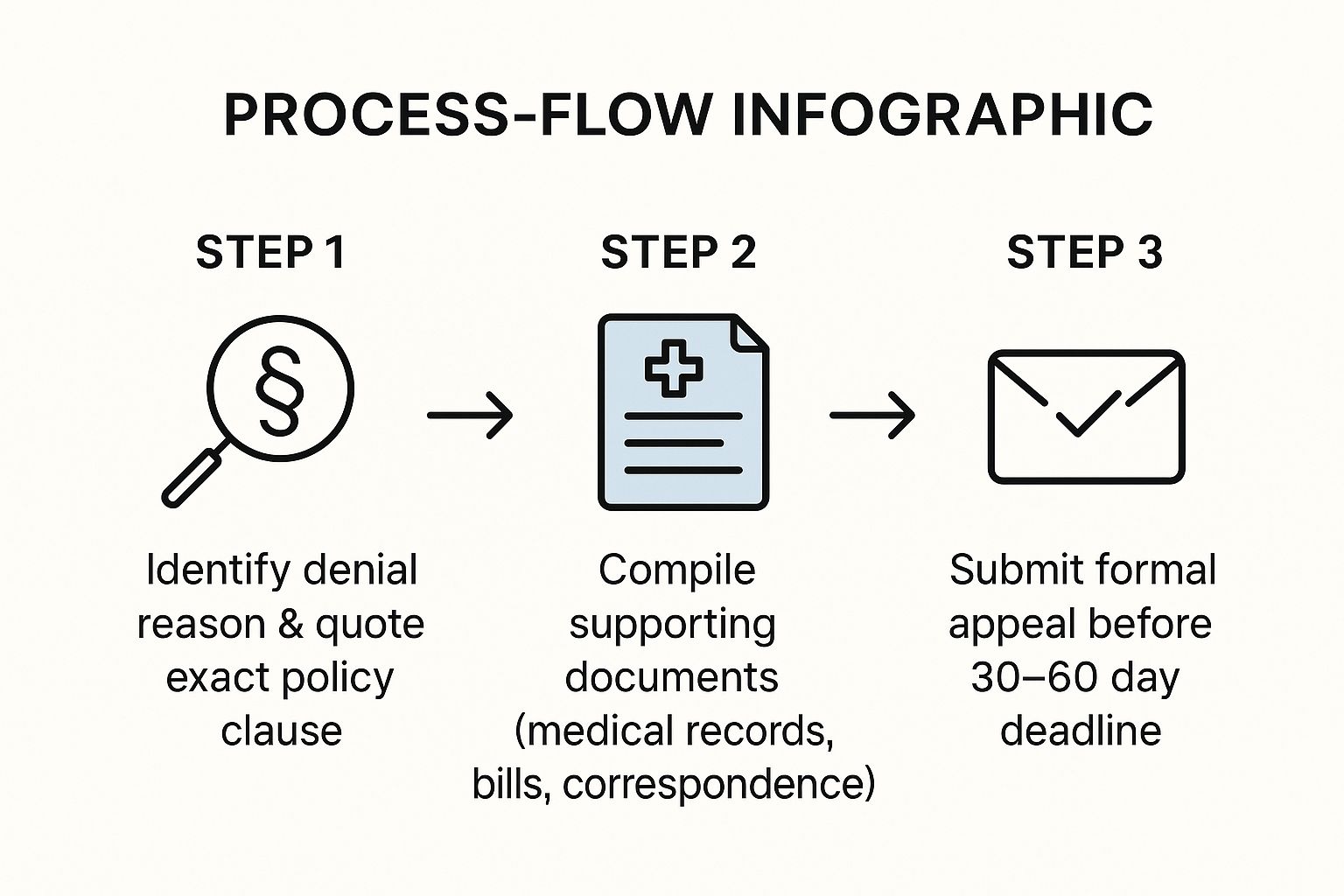
Have you ever received a decision that felt completely wrong? Whether it's a denied insurance claim, an inaccurate credit report, or an unfair performance review, the feeling of helplessness can be frustrating. A well-written rebuttal letter is your best tool for fighting back. It’s your chance to formally state your case, present evidence, and persuade someone to reconsider their decision.
This isn't just about disagreeing; it's about building a structured, professional, and convincing argument. The right words, backed by solid proof, can make the difference between accepting an unfair outcome and getting the resolution you deserve. A strong rebuttal shows you are serious and have a valid position that can't be ignored.
In this guide, we'll break down the process step-by-step. We're providing detailed rebuttal letter examples for six common but challenging situations. From disputing a tax assessment to challenging an academic peer review, you’ll learn exactly how to:
- Structure your letter for maximum impact.
- Present your evidence clearly and logically.
- Maintain a firm but professional tone.
Each example comes with a strategic breakdown, giving you the specific tactics and actionable insights needed to write a rebuttal that works. Let's get started.
1. Academic Peer Review Rebuttal Letter
An academic peer review rebuttal letter is a formal, point-by-point response to critiques from journal reviewers on a research manuscript. When you submit a paper for publication, experts in your field (peers) review it and provide feedback. Your rebuttal letter is your chance to address their concerns, clarify your methods, and convince the journal editor that your work is ready for publication after revisions.
This process is a core part of scholarly publishing. It ensures research is sound, methodologies are solid, and conclusions are well-supported. A strong rebuttal letter can be the difference between a paper's acceptance and rejection, making it one of the most critical rebuttal letter examples for academics and researchers.

Strategic Breakdown
The goal is to show the editor and reviewers that you have thoughtfully considered their feedback and improved your manuscript accordingly. It's not about winning an argument; it's about working together to make the paper better.
- Tone is Everything: Always remain professional and respectful, even if a reviewer's comment seems harsh or unfair. Start by thanking them for their time and valuable feedback.
- Structure is Key: Create a structured document that is easy to follow. A common format is to copy each reviewer's comment and then write your response directly underneath it.
Key Tactic: Use formatting like bold text for the reviewer's comment and regular or italicized text for your response. This makes the document scannable and shows clear organization.
Actionable Takeaways for a Winning Rebuttal
To make your rebuttal effective, focus on clarity, evidence, and precision.
- Address Every Single Point: Do not ignore any comments, no matter how small. Address each one individually to show you've been thorough.
- Be Specific About Changes: Don't just say you've "clarified the methodology." State exactly what you changed and where it is in the revised manuscript (e.g., "We have revised this section on Page 5, lines 112-118, to include the specific statistical tests used...").
- Provide Evidence for Disagreements: If you disagree with a reviewer's suggestion, explain why respectfully and back up your position with evidence, such as citing other established research or explaining the constraints of your study.
For a deeper dive into structuring your arguments, you can learn more about how a well-crafted rebuttal letter example can be adapted for different professional scenarios.
2. Insurance Claim Denial Rebuttal Letter
An insurance claim denial rebuttal letter is a formal appeal written to challenge an insurance company's decision to deny coverage. When your claim for health, auto, or home insurance is rejected, this letter is your first official step to contest the outcome. It allows you to present new evidence, correct misunderstandings, and argue that your claim should be covered based on the terms of your policy.
Dealing with an insurance denial can be frustrating, but a well-structured rebuttal is a powerful tool. It forces the insurer to re-evaluate their decision based on the facts and policy language you provide. This makes it one of the most essential rebuttal letter examples for anyone facing a disputed claim, turning a potential loss into a successful appeal.
The infographic below outlines the critical process flow for building a strong rebuttal letter.

This step-by-step process ensures your appeal is built on a solid foundation of evidence and submitted within the required timeframe.
Strategic Breakdown
The main goal is to prove, with documentation and direct policy references, that the denial was incorrect. You are not just asking for a reversal; you are building a logical, evidence-based case for why the original decision was flawed.
- Tone is Everything: Maintain a firm, formal, and professional tone. Avoid emotional language, anger, or threats. Stick to the facts of your claim and the language in your policy.
- Structure is Key: Organize your letter logically. Start by stating the purpose of the letter and referencing your claim number. Then, systematically address the reason for denial with your counter-arguments and supporting evidence.
Key Tactic: Quote the exact language from your insurance policy that supports your claim. Putting the insurer’s reason for denial right next to their own contractual language is a highly effective strategy.
Actionable Takeaways for a Winning Rebuttal
To build a compelling case, your rebuttal must be thorough, documented, and clear.
- Reference Specifics: Clearly state your policy number, claim number, and the date of the denial letter. This helps the insurer locate your file quickly and shows you are organized.
- Compile Comprehensive Evidence: Don't just state your case; prove it. Include copies (never originals) of all relevant documents, such as medical records, police reports, repair estimates, or photos of damage.
- Set Clear Expectations: Conclude your letter by stating what you want to happen next (e.g., "I request a full reversal of this denial and payment for the claim in the amount of $X"). Also, specify a reasonable deadline for their response, such as 30 days.
The principles behind crafting a strong insurance appeal are similar to those in commercial disputes. For more on this, you can learn more about chargeback dispute management, which also relies on structured, evidence-based responses.
3. Credit Report Dispute Rebuttal Letter
A credit report dispute rebuttal letter is a formal document sent to credit bureaus (like Equifax, Experian, or TransUnion) or creditors to challenge inaccurate information on your credit report. This letter is your official request to have an error investigated and corrected, such as an account that isn't yours, a late payment that was actually on time, or a debt that has already been paid.
Keeping an accurate credit report is essential for your financial health, as errors can lower your credit score and affect your ability to get loans, credit cards, or even housing. This makes the credit dispute one of the most practical and impactful rebuttal letter examples for personal finance, empowering you to take control of your financial record.
Strategic Breakdown
The goal of this letter is to clearly and concisely present your case, providing undeniable proof that an item on your report is incorrect. Your communication must be factual, professional, and easy for the credit bureau's investigators to process.
- Tone is Everything: Maintain a formal and objective tone. Avoid emotional language or accusations. State the facts plainly and professionally to ensure your dispute is taken seriously.
- Structure is Key: Your letter must be impeccably organized. Clearly state your personal information, the specific item you are disputing (including the account number), and a straightforward explanation of why it is wrong.
Key Tactic: Send your letter via certified mail with a return receipt requested. This creates a paper trail and proves when the credit bureau received your dispute, which is crucial since they have a legal deadline (typically 30 days) to respond.
Actionable Takeaways for a Winning Rebuttal
To build a compelling case, your dispute must be clear, well-documented, and persistent. When faced with inaccuracies on your financial record, it's crucial to understand how to dispute credit report errors effectively.
- Address One or Two Items Per Letter: Do not overload a single letter with multiple complex disputes. Focusing on one or two errors at a time makes it easier for the investigator to process and increases your chances of a successful resolution.
- Include Copies, Never Originals: Always attach copies of your supporting documents, such as bank statements, cancelled checks, or letters from creditors. Keep the original documents for your personal records.
- Be Explicit About the Desired Outcome: Don't just state that the information is wrong. Clearly request the action you want taken, such as, "Please remove this fraudulent account from my credit report," or "Please update this account to reflect on-time payment."
For more tactics on managing financial disagreements, you can learn more about how to win a credit card dispute.
4. Employment Termination Rebuttal Letter
An employment termination rebuttal letter is a formal document written by an employee to dispute the reasons for their dismissal. This letter serves as an official record to challenge the employer's decision, presenting evidence that contradicts the stated cause for termination, such as highlighting procedural errors, citing discriminatory practices, or providing proof of strong performance.
This type of letter is crucial for protecting your professional reputation and potentially opening the door for negotiation, severance, or even reinstatement. It allows you to formally place your side of the story into your personnel file, which can be vital for future legal action or references. Crafting a strong response is a key skill, making this one of the most important rebuttal letter examples for any professional.

Strategic Breakdown
The main goal is to create a factual, professional, and persuasive counter-narrative to the employer's termination reasoning. This isn't about venting frustration; it's a strategic move to correct the record and protect your interests.
- Tone is Everything: Remain calm, objective, and professional. Avoid emotional or accusatory language, as this can undermine your credibility. Stick strictly to the facts.
- Structure is Key: Organize your letter logically. Start by stating its purpose, then systematically address and refute each point from your termination notice with corresponding evidence.
Key Tactic: Reference specific company policies, employee handbook clauses, or state/federal laws that were violated during your termination process. This elevates your argument from a personal disagreement to a formal dispute based on established rules.
Actionable Takeaways for a Winning Rebuttal
To build a compelling case, your letter must be grounded in documented facts and clear, logical arguments.
- Address Every Single Point: Systematically take apart the employer's reasoning. For example, if terminated for "poor performance," counter this by referencing specific positive performance reviews, successful projects, or emails of commendation.
- Be Specific About Changes: Don't just claim the termination was unfair. State precisely what you are requesting, whether it’s a change in the termination reason in your official file, a review of the decision, or a severance negotiation.
- Provide Evidence for Disagreements: This is the most critical part. Attach copies of documents that support your claims, such as performance evaluations, emails, witness statements, or time sheets. For instance, if accused of tardiness, provide records showing you were on time.
5. Tax Assessment Appeal Rebuttal Letter
A tax assessment appeal rebuttal letter is a formal document used to challenge a property tax assessment or an IRS determination that you believe is incorrect or unfair. Whether you're a homeowner disputing a property valuation or a business owner contesting an audit finding, this letter is your primary tool for presenting your case with supporting evidence.
This type of rebuttal is crucial for ensuring you only pay what you legitimately owe. An inaccurate property assessment can cost you thousands over time, while an unchallenged IRS audit can lead to significant penalties. Creating well-reasoned rebuttal letter examples in these situations is a vital skill for both individuals and businesses to protect their financial health.
Strategic Breakdown
The goal of a tax appeal letter is to present a clear, evidence-based argument that persuades the tax authority to reconsider its position. You must demonstrate that their valuation or finding is flawed and that your proposed correction is accurate and justified.
- Tone is Everything: Maintain a formal, objective, and respectful tone. Your letter is a professional dispute, not a personal complaint. Avoid emotional language and stick to the facts presented in your documentation.
- Structure is Key: Organize your letter logically. Start by clearly identifying yourself, the property or tax period in question, and the specific assessment you are appealing. Then, present your arguments one by one, each supported by corresponding evidence.
Key Tactic: Use appendices or attachments for your evidence (e.g., appraisals, comparable sales reports, receipts). Label each piece of evidence and reference it directly in your letter, such as "See Appendix A: Comparable Sales Analysis."
Actionable Takeaways for a Winning Rebuttal
To build a compelling tax rebuttal, focus on precision, documentation, and following the procedure.
- Gather Comprehensive Evidence: For property tax appeals, this means collecting data on at least three to five comparable properties ("comps") that have recently sold for less than your assessed value. For IRS disputes, gather all relevant receipts, financial statements, and legal documents that support your tax filing.
- Be Specific and Factual: Don't just claim your assessment is "too high." State exactly what you believe the correct value is and why. For example: "The county's assessed value of $550,000 is inaccurate. Based on three recent comparable sales in the same neighborhood (see Appendix A), a more accurate market value is $495,000."
- Meet All Deadlines: Tax authorities operate on strict deadlines. Missing a filing deadline can result in an automatic dismissal of your appeal, regardless of how strong your case is. Mark your calendar and submit your letter well in advance.
Mastering the art of a well-documented dispute is a valuable skill, much like learning how to win a credit card dispute with compelling evidence.
6. Customer Service Complaint Rebuttal Letter
A customer service complaint rebuttal letter is a formal document used to escalate a dispute when initial attempts at resolution have failed. You write this letter after receiving an inadequate response (or no response at all) from a company's standard customer service channels. Its purpose is to bypass frontline support and bring your issue directly to a supervisor, manager, or corporate office.
This letter systematically documents your negative experience, outlines previous communication, and formally requests a specific, reasonable resolution. For consumers dealing with issues like airline flight cancellations, incorrect utility bills, or defective products, this is one of the most powerful rebuttal letter examples for getting results and holding companies accountable.
Strategic Breakdown
The goal of this letter is to present a clear, organized, and undeniable case that compels a higher-level employee to take action. It transforms you from a frustrated customer into a well-documented claimant who cannot be easily ignored.
- Tone is Everything: Maintain a firm, factual, and professional tone. Avoid anger or sarcasm, as this can undermine your credibility. The goal is to be taken seriously, not to vent frustration.
- Structure is Key: Present your case chronologically. Start with the initial problem, detail your attempts to resolve it, explain why the company's response was unsatisfactory, and conclude with your desired outcome.
Key Tactic: Use a clear subject line like "Formal Complaint Regarding Order #12345" or "Escalation of Unresolved Service Issue - Account #67890." This immediately signals the letter's serious nature and helps route it correctly.
Actionable Takeaways for a Winning Rebuttal
To make your complaint rebuttal effective, you must provide a complete and easy-to-follow record of the entire incident.
- Document Everything Meticulously: Include dates, times, names of representatives you spoke with, and reference numbers for all previous communications. This shows you've been diligent and creates a timeline of the company's failure to resolve the issue.
- Be Specific About Your Desired Resolution: Don't just complain; propose a solution. Clearly state what you want, whether it's a full refund, a product replacement, or a specific amount in compensation for damages or inconvenience. This makes it easier for the company to approve your request.
- Provide Undeniable Evidence: Attach copies of all relevant documents: receipts, contracts, email correspondence, photos of a defective product, or screenshots of billing errors. Evidence makes your claim difficult to dispute.
To better understand the perspective of the party receiving a complaint, you can read these effective tips for dealing with customer complaints. Knowing how the other side operates can help you frame your argument more persuasively.
For a deeper dive into managing customer interactions from a business perspective, explore these insights on how to handle customer complaints.
Rebuttal Letter Types Comparison
Automate Your Disputes and Focus on Growth
Navigating the world of disputes can feel like a constant battle. As we've explored through various rebuttal letter examples - from academic appeals to insurance claims - the core principles of a successful rebuttal stay the same. A winning argument is built on clear evidence, a professional tone, and a logical, easy-to-follow structure. Each example showed a specific strategy, whether it was using a timeline to challenge an unfair termination claim or leveraging specific policy clauses to overturn an insurance denial.
The real power lies not just in understanding these templates, but in mastering the strategies behind them. Your goal is to make it impossible for the other party to ignore your facts. By presenting a case that is organized, evidence-backed, and direct, you remove ambiguity and force a decision based on the merits of your position. This strategic approach transforms a rebuttal from a simple letter of disagreement into a powerful tool for resolution.
Key Takeaways for Crafting Winning Rebuttals
Reflecting on the different rebuttal letter examples in this guide, several core lessons stand out. These are the actionable principles you can apply to almost any dispute you face:
- Evidence is Everything: Your claims are only as strong as the proof you provide. Always lead with concrete evidence like receipts, emails, signed documents, or photographic proof. Without it, your letter is just an opinion.
- Stay Calm and Professional: Emotion clouds judgment and weakens your argument. A calm, objective, and professional tone commands respect and shows you are serious about finding a fair resolution, not just venting frustration.
- Structure Your Argument Logically: Guide the reader through your case step-by-step. Use headings, bullet points, and a clear timeline to make your points easy to understand and digest. A confusing letter is an ineffective one.
- Be Specific and Direct: Avoid vague language. Clearly state the issue, what you believe is incorrect, and what specific outcome you are seeking. Directness eliminates confusion and sets clear expectations for resolution.
From Manual Effort to Automated Success
For individuals, mastering these techniques is a valuable life skill. But for an e-commerce merchant, the sheer volume of disputes, particularly chargebacks, makes writing rebuttals by hand an unsustainable drain on resources. Manually crafting a detailed, evidence-rich letter for every single chargeback is not just time-consuming; it's a direct obstacle to focusing on what truly matters: growing your business.
This is where the principles we've discussed can be scaled through technology. Instead of getting bogged down in the administrative trenches, you can use automation to handle the entire dispute process. Imagine a system that instantly analyzes a chargeback, gathers the relevant order data, and constructs a compelling, data-driven rebuttal based on proven strategies. This shifts your role from a constant fighter of disputes to a strategic business owner, secure in the knowledge that your revenue is being protected efficiently and effectively. The future of dispute management isn't about writing better letters; it's about automating them so you can get back to business.
Tired of losing revenue to chargebacks? Let ChargePay handle the fight for you. Our AI-powered automation uses the same evidence-based principles from these rebuttal letter examples to build and submit winning chargeback disputes on your behalf, so you can recover lost revenue effortlessly. Learn more and get started with ChargePay today!







.svg)







.svg)
.svg)
.svg)